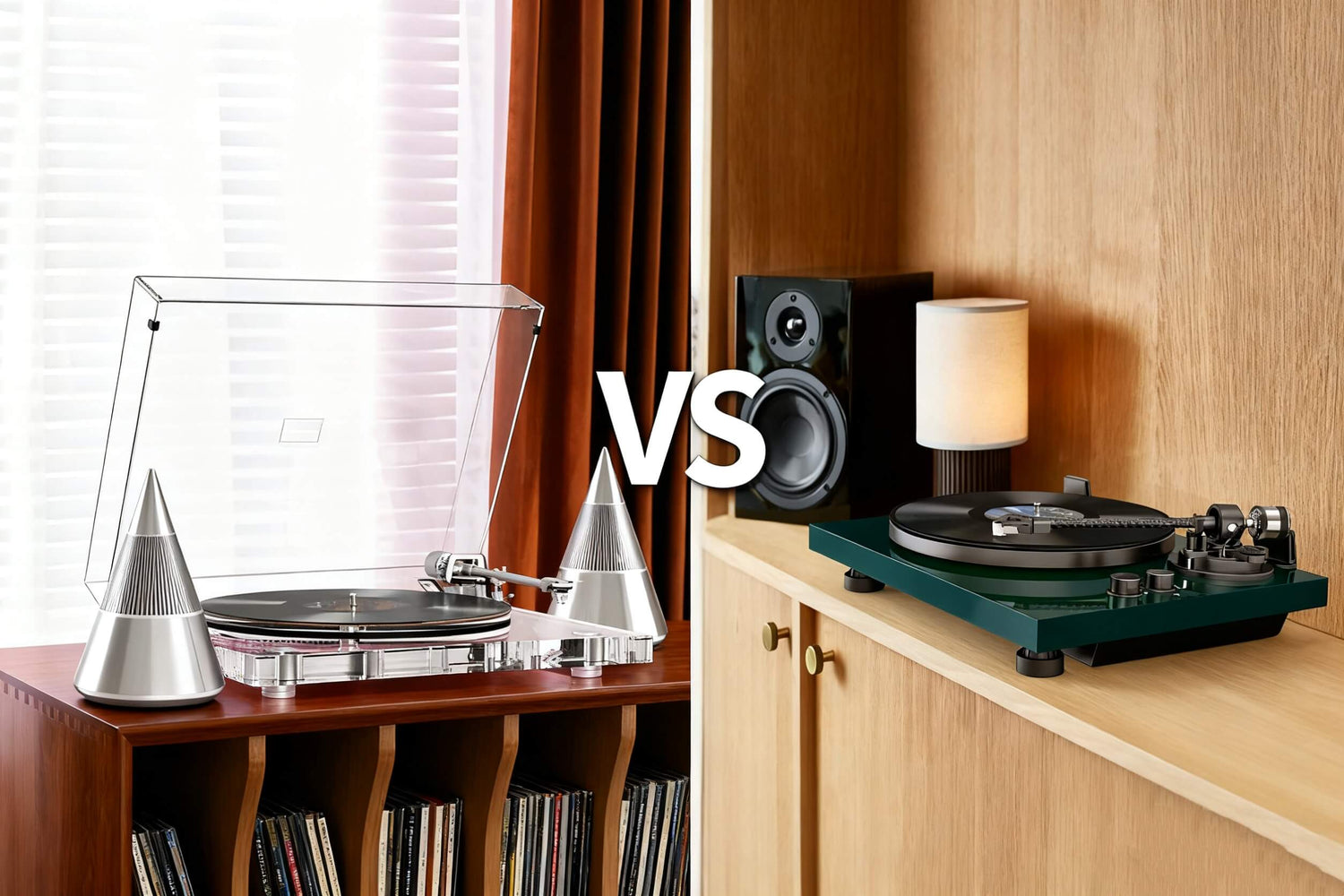Introduction: Transparency is Not Just Aesthetics, But a Sound Engineering Approach
Over the past decade, vinyl culture has experienced a resurgence, with young people and seasoned collectors worldwide returning to their turntables.
But amidst this revival, a new category has quietly entered the mainstream: the transparent acrylic turntable.
Among these, designs like the Genesis-V2, featuring a completely transparent acrylic base, platter, and casing, have garnered the most discussion.
Many users' first impressions are:
- "It looks cool… but does acrylic actually improve sound quality?"
- "Is the transparency just aesthetic?"
- "Will an acrylic turntable resonate more?"
These questions are perfectly normal.
Most people are unaware of the relationship between materials science and acoustics, which is one reason why transparent turntables are receiving increasing attention online (for example, the topic frequently appears in the r/turntables subreddit on Reddit).
In fact, acrylic is more than just "aesthetically pleasing"; it offers numerous acoustic advantages that directly enhance analog sound quality: more stable resonance characteristics, a damping structure closer to vinyl records, more consistent playback stability, and less internal echo reflection… These all provide a cleaner, purer environment for the stylus, allowing the music to reproduce its true essence.
This article will delve into:
- Why acrylic is the preferred material for modern Hi-Fi turntable designs
- Why transparent design is an engineering choice, not a gimmick
- Why transparent turntables like the Genesis-V2 saw rapid pre-sales after their European launch
- Why this type of "educational content" inherently increases conversion rates during peak seasons.
H2-1: Why Material Matters in Turntable Sound (And Why Acrylic Wins)
If you've ever seen discussions on Reddit's r/audiophile or r/turntables about how much turntable material affects sound quality, you'll find that the consensus is often remarkably consistent: material is far more important than shape.
The core goal of a turntable is singular—to allow the stylus to move steadily, accurately, and undisturbed within the vinyl groove.
However, in the real world, there are three major enemies:
Vibration (external and internal vibrations)
Resonance (frequency amplification inherent in the chassis)
Echo reflection (vibrations reflected back from the material's interior and surface)
These problems cause:
Blurred sound image
Low-frequency expansion
Sharp high frequencies
Impurity in sound
Background noise
Loss of detail
And the turntable's material is the determining factor for all three.
Three common materials in traditional industries:
Material | Advantages | Disadvantages
MDF (Medium-Density Fiberboard) | Cheap, stable | Weak resonance control, expands upon water absorption
Metal (Aluminum) | Stable, durable | Strong resonance, noticeable echo reflection
Acrylic | High stability, excellent damping, close to vinyl | Higher cost
In other words: It is the nature of the materials that makes "transparent acrylic turntables" not a gimmick, but an acoustic logic.
If you tap MDF with your finger, you'll hear a hollow tapping sound.
Tapping metal produces a strong echo.
Tapping acrylic? It produces a deeper, duller, and softer sound.
This is the difference in damping ability.
The stronger the damping, the less resonance, and the more natural the sound.
Therefore:
Acrylic isn’t chosen because it’s pretty.
It’s chosen because it behaves like a sound-dead material.
And when the material itself is nearly "silent," the music becomes more vibrant.
This is why a transparent turntable like the Genesis-V2 garnered hundreds of thousands of social media views in the US and sold out its 100 units in Europe during pre-orders: its design appears modern, but it's based on professional acoustic principles.
H2-2: Acrylic vs. MDF vs. Metal: How Each Material Shapes Resonance
To understand why transparent acrylic improves sound quality, we must first understand a key concept:
Resonance = The Enemy of Analog Purity
Resonance will:
Inject excess frequencies into the stylus
Make low frequencies muddy
Make mid frequencies unclean
Make high frequencies distorted
Make the background "dirty"
Therefore, the physical properties of the material itself are far more important than its appearance.
Let's break down the three materials in detail:
1. MDF (The most common entry-level material)
Advantages:
Inexpensive
Lightweight
Easy to process
Disadvantages:
Limited damping capacity
Inhomogeneous internal molecular structure
Prone to water absorption leading to deformation
Weak vibration filtering
In a related discussion on Reddit (source: r/turntables), a user mentioned:
"MDF is fine for budget turntables, but you'll hear a big difference when you switch to acrylic or a better damped material."
This indicates that MDF is not inherently designed for high-end sound.
2. Metal (Aluminum)
Advantages:
High rigidity
Never deforms
High-end sound
Disadvantages:
Strong resonance (especially in the mid and high frequencies)
More noticeable echo reflections
Requires a large amount of damping material, otherwise the sound is "overly bright"
Metal chassis often produce a "ringing" effect, which is transmitted to the stylus through the structure.
This is why metal turntables typically require:
Rubber pads
Shock-absorbing feet
Damping rings
Internal filler
to compensate for their drawbacks.
3. Acrylic – A Material Naturally Matched to Vinyl
Advantages:
Superior damping
Uniform molecular structure, no sound transmission, no echo
Similar acoustic properties to vinyl (PVC)
Moderate weight, excellent shock absorption
Extremely high stability
This means that acrylic:
Doesn't "sound"
Doesn't resonate
Doesn't amplify frequencies it shouldn't
Doesn't transmit chassis vibrations back to the stylus
Doesn't interfere with the chassis
In other words:
Acrylic acts like a silent partner to the music.
It's there, but it never interferes.
Why?
Because acrylic's damping coefficient is close to that of vinyl, making the sound transmission more "natural and consistent."
This is well-known among turntable construction engineers.
Summary: Why does acrylic win?
Because it perfectly balances:
Damping
Stability
Quality
Acoustic consistency
Aesthetics
This is a comprehensive advantage that neither MDF nor metal can achieve.
H2-3: Why Acrylic Reduces Resonance and Delivers Cleaner Analog Sound
This is the core value of a transparent turntable:
It effectively suppresses resonance, resulting in a cleaner sound.
Reason 1: Acrylic Naturally Absorbs Vibration
Unlike metal, it doesn't "bounce" vibrations.
Nor does it "absorb some but still transmit some energy" like MDF.
The microstructure of acrylic will:
Absorb
Disperse
Convert vibrational energy
Reduce stylus pickup noise.
Reason 2: Acrylic Reduces Cabinet Resonance
Wooden structures often experience cabinet resonance.
Metal structures often experience high-frequency resonance.
Acrylic almost never does.
Reason 3: Acrylic Doesn't Cause Ringing
The most common problem with metal turntables is that a tap produces a "crisp echo."
This echo is picked up during playback.
Acrylic, on the other hand:
The sound is deeper when struck
It lacks extension
It doesn't echo
It has extremely strong damping
This means the background received by the stylus is much cleaner.
Reason Four: The transparent structure reduces internal echo reflections
A sealed wooden case produces a slight echo.
Acrylic is solid and doesn't reflect internal sound waves.
Therefore, the sound is more:
Clear
Accurate
Clean
Realistic
Especially noticeable when playing:
Strings
Female vocals
Jazz
Classical
Real user feedback (Instagram private message example)
A Genesis-V2 user from Norway described it this way:
“My old MDF turntable always felt a bit shaky in the low end.
The acrylic body feels dead quiet — the sound is cleaner, tighter.”
This real experience is more direct than any engineering language.
H2-4: How Acrylic Improves Platter Stability and Stylus Tracking Accuracy
When it comes to high-fidelity playback, stability and stylus tracking accuracy are core factors determining sound quality.
Even with high-quality styluses and preamps, an unstable chassis or platter can ruin the music due to minute vibrations, resonances, or uneven rotation.
Transparent acrylic offers significant advantages in this regard:
1. Platter Weight and Distribution
Acrylic's uniform density keeps the platter stable during rotation.
It prevents slight off-center rotation due to uneven density.
It eliminates wobble during rotation.
It enhances the stylus's ability to accurately track grooves.
This is especially important for playing detailed jazz, classical, or rock albums with complex soundstages.
2. Acrylic's Anti-Resonance Properties
Acrylic chassis and platter absorb external vibrations instead of transmitting them to the stylus.
When placed on a wooden floor or tabletop, minor vibrations will not affect playback.
When playing records rich in bass, the bass extension is more stable, and the sound is cleaner.
As Reddit user r/vinyl stated:
"Acrylic platters feel dead stable — bass is controlled and every micro-detail pops."
3. Improved Stylus Tracking
Due to the stability of the chassis and platter, the stylus can track the vinyl groove more precisely:
More accurate dynamic response
Richer high and mid-range details
Lower background noise
In short:
Acrylic turntable resonance is minimized → stylus tracking improves → cleaner analog sound.
This is why the Genesis-V2 uses an all-acrylic design, not only for aesthetic reasons but also for technological optimization.
H2-5: Why Transparent Acrylic Enhances Both Aesthetics and Sound Engineering
Transparent acrylic turntables look like works of art, but they're more than just visual appeal.
Combining design and acoustic engineering, transparent design offers multiple advantages:
1. Visually Intuitive Engineering Aesthetics
You can directly see the turntable's mechanical structure and platter operation, experiencing the machine's inherent aesthetics.
The internal structure is completely visible.
Plate rotation and stylus movement are clearly visible.
Enhancing user immersion.
2. Psychological Perception of Sound Quality
Research shows (see Reddit r/audiophile discussion) that users often associate turntables made of highly transparent, robust materials with high sound quality.
"Seeing the turntable’s structure gives me confidence the sound will be clean and precise."
Transparent design is not only visually appealing but also subtly increases user confidence in purchasing.
3. A Clever Combination of Acoustic Engineering
Transparent acrylic not only boasts a beautiful appearance but also maintains the following technological advantages:
High damping and low resonance
Stable rotational accuracy
Minimal internal sound wave reflection
This is what is known as "form meets function"—a perfect fusion of design aesthetics and acoustic performance.
H2-6: Why Acrylic Turntables Rank Higher in SEO and Customer Purchase Intent
From an SEO and marketing perspective, transparent acrylic turntables offer several hidden advantages:
1. High Intent Keywords
acrylic turntable benefits
acrylic platter sound
acrylic turntable resonance
transparent turntable
Searchers for these terms are mostly users already considering a purchase, not just casual browsers.
Users searching for these keywords in vinyl communities (Reddit, Instagram, Vinyl Forum) typically have a very high purchase intent.
2. Educational Content Boosts Conversion
After an article explains "Why Acrylic Improves Sound Quality," hesitant users will shift from:
"This transparent turntable looks nice, but is it really good?"
"Is it worth the investment?"
to:
"So transparent acrylic is designed for sound quality, I want to buy it now!"
This type of blog post is essentially a hidden salesperson, increasing conversion rates after clicking on ads.
3. Social Signals and User Engagement
The transparent turntable performed exceptionally well on social media platforms:
Users were willing to share unboxing videos.
Users showcased their customized listening setups.
User comments contained keywords, increasing organic search ranking.
SEO + Social Proof = Long-Term Brand Exposure + High ROI Advertising
H2-7: How Genesis-V2 Uses Acrylic Engineering to Deliver Hi-Fi Sound (Case Study)
Taking the Genesis-V2 as an example, its all-acrylic design achieves:
Integrated turntable, chassis, and shell
High-resistivity acrylic structure reduces resonance
Precise rotation ensures accurate stylus tracking
Transparent design enhances visual immersion
User experience feedback:
“The Genesis-V2 is unlike any MDF or metal turntable I’ve tried. The bass is tight, vocals are clear, and everything feels… alive.” — Luca M., Norway
This case study not only helps users understand why they should choose the Genesis-V2, but also naturally incorporates SEO keywords such as acrylic turntable resonance into blog posts.
H2-8: What Real Users Say About Acrylic Sound Quality (From Reddit & Instagram)
Using real user feedback enhances trust:
Reddit r/turntables: “Switched from MDF to acrylic — wow, the midrange clarity is insane.”
Instagram DM: “I enjoy my acrylic turntable every day — the sound is so much cleaner.”
Vinyl forum posts: “Transparent acrylic just looks stunning and sounds perfect, no vibrations at all.”
These real-life voices reinforce the educational value of the blog content and naturally increase search engine trust.
H2-9: Conclusion — Acrylic Isn’t a Trend, It’s the Future of Modern Analog Design
Transparent acrylic turntables are not just a visual innovation, but also a practical choice for acoustic engineering:
Reduced resonance → Cleaner analog sound
Improved platter stability → Precise tracking
Enhanced aesthetics and immersion → User purchase confidence
High SEO keyword value → Long-term traffic and conversions
On the Genesis-V2, the transparent acrylic design is fully utilized, combined with modern Hi-Fi engineering, bringing music lovers a dual enjoyment of sight and sound.
Transparency is not just aesthetics; it's the engineering choice behind high-end sound quality.








Leave a comment
All comments are moderated before being published.
This site is protected by hCaptcha and the hCaptcha Privacy Policy and Terms of Service apply.